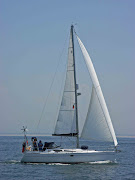Interestingly the French word used in weather forecasts for a blow or puff of wind is souffle – nothing to do with soufflé they say!
Another factor that put us off sailing to Ciudadela at the western end of the Island was the forecast of a phenomenon known as the resaca or seiche whereby in certain meteorological conditions the sea level rises and falls by as much as 1.5 metres every ten minutes or so, an oscillation that can continue for several days and make it uncomfortable if not dangerous in the town’s harbour and nearby anchorages. This phenomenon, that nobody appears to be able explain can be experienced along the south coast of the Island and as far away as Palma, Mallorca.

At the entrance to Mahon or, more correctly, Mao harbour we passed La Punta S’Espero, the most easterly point in Spain. The harbour at 5 kilometres long by 900 metres wide is the world’s second largest natural harbour some say, Sydney being the largest. Have they not heard of Poole harbour? It is a very large and sheltered harbour whatever and, bearing in mind its strategic position in the western Mediterranean, it is no wonder that it was fought over by the European powers during the 18th century, the British occupying the Island from 1708 to 1802 with very short interruptions from France and Spain. High on the cliff between Mao and En Castell, the most easterly town in Spain, stands the Georgian villa once the home of Admiral Collingwood, Nelson’s second in command, and on the north cliff across the harbour the beautiful Hacienda San Antoni where Nelson once stayed in 1799. Three Islands are situated in the harbour. The British built a hospital on the Illa de Rey that then became known as Bloody Island and the other two, Illa Plana and Illa Lazareto were used by them as quarantine Islands. Sailing further up the harbour the city of Mao appears as a jumble of attractive whitewashed houses perching atop the sheer cliff faces that grow directly from the deep clear water of the harbour.

Mao has a British feel reflecting its former government. It still retains some very English elements: sash windows, green shutters and brass doorknockers among them. There is even a Gin distillery here to this very day. The National Geographical Magazine’s description of the Menorcan capital in 1928 as ‘a maze of blinking alleyways leading up and down hill, lined with bright dolls’ houses’ still holds true. It is an enchanting place.

Mao has two major churches. In the Esglesia de Santa Maria music from the mighty 3,210 piped Swiss organ echoed around the dark foreboding edifice. Meanwhile in the Esglesia del Carme the tender strains of Mozart filled the bright yet austere interior. In stark contrast the Beatles were being piped throughout the latter church’s cloisters now gainfully used as the town market.
We moored stern to the harbour Authority’s floating pontoon ‘Isla Clementina’ overlooking the old town. From her we can take the dinghy the short ride to town. ‘Isla Clementina’ has the usual water and electricity on tap but also the luxury of a swimming pool, gardens and a shower! The Port Authority chap comes from Barcelona but its OK his name is Alfonso, not Manuel!

We took a bus through the centre of the Island with its dry stone walled fields alive with the colour of wild flowers and stocked with Frisian cows imported by the British in the 18th century. The terrain is undulating but the hills are low, the highest being Monte Toro in the centre of the Island at 357 metres. Our destination, Ciudadela, was the capital of the Island before the British moved the seat of government to Mao in 1722 because of the superior harbour there. Ciudadela may have lost its power but it retains fine Catalan and Italian styled 16th and 17th century palazzi with their richly adorned facades and an impressive Cathedral with brightly coloured stained glass windows all set in narrow arcaded streets and shady squares. This city of only 21,000 population abuts a small but picturesque harbour.

Fornells pronounced ‘Fornays’ is a village of whitewashed houses with 498 inhabitants on the shores of the lovely Cala of the same name on the north coast of the Island. The village is famous for its Spiny Lobster for which Juan Carlos, the King of Spain, regularly sails here from Mallorca to savour. The surroundings to the Cala are of unspoilt natural beauty.
It has suddenly struck me why Menorca seems so much different to the Spanish mainland and to some extent Mallorca and that is the fact that there was only one crane on the skyline of Fornells! Indeed now that I look I can only see two in Mao.

We have anchored in some deserted and unspoilt Calas in sparkling clear water over white sand surrounded by wild flower and tree clad rocky shores. We were fortunate to have this seclusion as in the season we gather that these beautiful inlets are crowded to overfilling with boats and holidaymakers on the beaches.

We are at this moment waiting in Mao in gale force winds for an opportunity to sail the 200 miles to Sardinia. Not far to the north of us along the French coast and in Corsica and Sardinia itself it is blowing storm force 10 with 6 metre waves. We reckon, having looked at various Internet forecasts, that we will not have more conducive weather for the crossing until later on this week. Never mind this is not a bad place in which to be stormbound.
Ciao. A piu tardi









